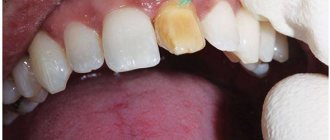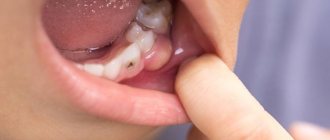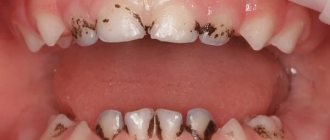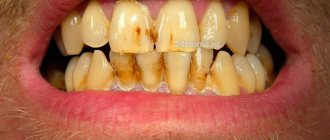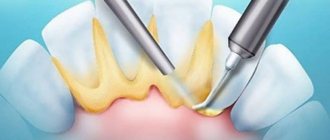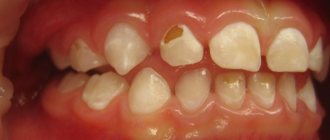In most cases, dental plaque is the cause of insufficient oral hygiene. But it also happens that people who are very sensitive to hygiene issues develop black plaque on their teeth.
The reasons for its appearance in adults and children differ : if in the former it is a consequence of drinking large amounts of tea and coffee, as well as smoking, then in the latter it may be associated with the activity of certain bacteria, the use of mouthwashes and the use of chewable vitamins.
Types of plaque
Plaque on teeth is divided into two large groups:
- the occurrence of which is associated with external contamination of the tooth;
- appearing due to the deposition of pigments.
If oral hygiene is not maintained, plaque may appear on the teeth:
- soft microbial;
- mineralized;
- hard, often called tartar.
If everything is in order with hygiene, then black plaque is a consequence of:
- regular consumption of tea, coffee and nicotine;
- use of medications with high iron content;
- vital activity of chromogenic bacteria;
- use of certain types of rinses and antiseptics.
Bacterial plaque on teeth: causes
Soft or, as it is also called, bacterial plaque has a soft consistency, so it is easy to get rid of it with the help of an ordinary toothbrush. The main place of its accumulation is the neck of the teeth.
Harder plaque that cannot be removed with a brush is called tartar. It occurs during the mineralization of soft plaque with phosphorus and calcium salts present in saliva.
Why does plaque form?
There are constantly a huge number of bacteria in the mouth, which, firstly , multiply, and secondly , leave behind waste products. Even if you brush your teeth regularly, plaque cannot be avoided: within 6 hours after thorough brushing, you can easily notice, without resorting to the use of specialized equipment, a bacterial mass on the surface of the tooth enamel. A surge in microbial activity is observed immediately after eating: leftover food in the mouth forces bacteria to begin intensive processing.
At the same time, even small pieces of food that are invisible to the human eye are enough for microorganisms: they can feed on a film consisting of carbohydrates and proteins that invariably remains on the surface of the teeth after eating, and on food debris that gets into the spaces between the teeth. In this regard, it is imperative to brush your teeth for 15 minutes after each meal, since the mass of bacterial plaque can increase several times in volume in 1-2 hours. Plaque accumulates especially intensely on the necks of teeth in people who like to snack on a bun or something sweet between main meals.
Almost immediately after the soft plaque appears, the process of mineralization begins, as a result of which it gradually hardens. The period of primary mineralization (i.e., when the plaque, in simple terms, “sets” but still remains loose) is 10-15 hours. When the plaque finally hardens, its surface becomes ideal for the formation of deposits.
Features of "Chlorhexidine"
When the drug comes into contact with a fungus or bacteria, the antiseptic properties of Chlorhexidine are activated, as a result of which the microorganism dies. The product can cope with any form of bacteria, but, unfortunately, it is powerless in the fight against viruses. The virus shell is quite dense, which is why the active components of the drug are unable to dissolve it.
"Chlorhexidine"
Among all the advantages of the medicine, it is worth noting its long-lasting effect, since “Chlorhexidine”, when rinsed, creates a protective film on the surface of the mucous membrane, which does not disappear for 4-5 hours. The drug can also be used after removal of the hole, as it is able to destroy harmful bacteria in the presence of blood. For this reason, dentists recommend taking Chlorhexidine after various dental procedures.
Chlorhexidine is available without a prescription
Video: Chlorhexidine, instructions
Pigmented dark plaque on teeth
The main reason for the appearance of such plaque in adults is smoking, drinking coffee and tea. Maintaining hygiene guarantees the absence of bacterial plaque and tartar, but if you neglect it, black plaque will not take long to appear. Pigments adhere very well to enamel covered with bacterial plaque formed as a result of infrequent brushing of teeth.
Types of pigment plaque include:
- brown coating that occurs from regular consumption of tea and coffee in large quantities;
- accumulation of nicotine deposits;
- darkening of the enamel as a result of taking medications containing iron;
- proliferation of bacteria that form dyes (they are called chromogenic);
- change in enamel color after using antibiotics;
- blackening due to diseases of internal organs.
If plaque is caused by bacterial factors, then regular thorough brushing of teeth, the use of rinses and floss reduce the likelihood of its occurrence to a minimum. However, if the reason for the appearance of plaque lies in the influence of dyes, maintaining hygiene to prevent it will not help.
Black plaque on children's teeth , the causes of which are associated with the activity of chromogenic anaerobic bacteria, appears in the form of spots localized in the neck area. Actinomycete bacteria produce hydrogen sulfite, which reacts with iron (found in saliva and red blood cells). As a result, a form of black iron that cannot be cleaned off with a regular brush is deposited on the surface of the teeth. Chromogenic coloration can also be orange, green and brown.
Black plaque on a child’s teeth can also form for other reasons . It appears due to:
- the use of antiseptics that contain chlorhexidine, benzaclonium chloride, as well as essential oils (the latter are found in the popular Listerine product);
- consumption of foods rich in iron, as well as vitamins with a high content of iron.
Can children rinse their mouths with Chlorhexidine?
Tooth extraction may also be required in childhood. Typically, this measure is required when baby teeth are loose, but in case of severe carious lesions, molars may also need to be removed. Preventive treatment with antiseptics in childhood is especially necessary. This is due to several factors:
- insufficient activity of the immune system to suppress the growth of pathogenic microorganisms;
- poor hand hygiene and non-compliance with sanitary standards;
- increased sensitivity of the gums and soft tissues surrounding the tooth to the effects of pathogenic bacteria and inflammatory processes.
Can children rinse their mouths with Chlorhexidine?
If necessary, Chlorhexidine can be used in childhood, but the rules of use will differ from the preventive treatment of adult patients. For children, it is recommended to dilute the drug with boiled water in a ratio of 2:1 (2 parts Chlorhexidine - 1 part water). You should rinse your mouth strictly under adult supervision and only if the child knows how to spit out the product and does not swallow it.
The number of procedures is also slightly reduced. The maximum permissible number of rinses in childhood is 2 times a day. The course of prevention depends on the age of the child. Approximate norms are presented in the table below, but they may vary depending on the condition of the oral cavity, the complexity of removal and other individual characteristics of the child.
Treatment of a child with the drug is allowed
Table. The duration of the course of use depends on the age of the child.
| Child's age | Course of use after tooth extraction |
| 2-5 years | 3 days |
| 5-8 years | 5 days |
| 8-14 years | 7 days |
How to remove plaque from teeth on your own
Many people do not like to visit the dentist again, especially when it comes to removing plaque, which does not cause much inconvenience. The reasons for this are clear: lack of free time and reluctance to pay for the procedure.
You can try to remove plaque from your teeth at home, but this will only work if there are no subgingival deposits and the plaque layer is thin.
The first method involves using a special toothpaste to remove plaque with abrasive substances. The label of such pastes must indicate the RDA indicator, indicating the degree of abrasiveness. In pastes that eliminate plaque, its value should exceed 100. But such pastes cannot be used on an ongoing basis. If the paste contains pyrophosphates, then it can help get rid of tartar, since they have the ability to dissolve its matrix.
The most effective of these pastes are:
- President White Plus. The abrasiveness index is 200 units; in addition, the composition contains silicon dioxide, which has abrasive and polishing properties. You should not use the paste more than once a week.
- Lacalut White. According to the abrasiveness index (RDA=120), it is more gentle than the previous sample. The composition contains pyrophosphates, which make the plaque loose.
The second method is to use a special toothbrush, which allows you to remove plaque yourself. Recommended use:
How to prevent gum disease
Any doctor will say with confidence that preventing a disease is much easier than curing it later. This also applies to gum inflammation. By regularly taking preventive measures, you can protect your body from unpleasant diseases. Below are step-by-step instructions to prevent the development of gum inflammation.
Table. Methods for preventing the inflammatory process.
- Rinse after tooth extraction with Chlorhexidine
| Steps, photo | Description of actions |
| Step one | Pay enough attention to brushing your teeth, doing this procedure at least twice a day. This will protect your teeth from plaque formation, as well as restore the microflora in the oral cavity. The duration of each procedure should not be less than 2 minutes. If possible, brush your teeth after every meal. Don't forget to clean your tongue and cheeks as this is where most bacteria accumulate. |
| Step two | Floss regularly. Many people neglect this wonderful and effective device, but regular flossing will remove plaque from hard-to-reach places where a regular toothbrush cannot reach. When flossing, you need to be careful not to damage the gum tissue. Otherwise, in addition to inflammation, you will need to treat the resulting bleeding of the gums. |
| Step three | Make sure you have enough vitamins in your diet. The body should receive a lot of folic acid, calcium and vitamin C. To do this, you should review the diet and, if necessary, adjust it slightly. Experienced nutritionists recommend adding more citrus fruits, lentils, beans, broccoli, grains, fish, dairy products, strawberries, melons and so on. All these products contain sufficient amounts of vitamins and minerals, which are so beneficial for teeth and gums. |
| Step four | Never use lemon juice or vinegar to rinse your mouth, even if your good friend who has previously performed this procedure advises it. This is an acid that, when in contact with tooth enamel, can destroy it. It is better to rinse the oral cavity with plain water. |
| Step five | It is known that severe stress or lack of sleep negatively affects the immune system, which ultimately leads to the development of many diseases. A weakened body is not able to resist various infections and viruses, so to strengthen it, try to be less nervous. You also need to devote enough time to sleep. Exercise, read books, or do other calming activities. But it is advisable to give up computer games, because it is the computer that causes stress the most. |
| Step six | Give up bad habits, in particular smoking. Nicotine negatively affects the health of the gums and the body as a whole. Therefore, in order to prevent the inflammation from developing again, you should still quit smoking. |
| Step seven | Visit your dentist's office at least twice a year, even if you don't have any problems with your teeth or gums. Preventive examinations will allow you to promptly identify pathology at an early stage of development and cure it as quickly as possible. Just start a new habit - visit the dentist regularly, and soon you will forget about problems with your oral cavity. |
Often, when the gums are inflamed, the patient experiences pain, so if pain occurs, immediately seek help from a doctor, because this may indicate the development of gum disease. After the examination, the dentist will prescribe appropriate therapy. Usually people themselves are to blame for gum problems, as they constantly ignore the rules of oral hygiene. But there is nothing difficult about brushing your teeth twice a day and changing your toothbrushes regularly.
Teeth cleaning
To prevent inflammation, you need to avoid food that is too cold or hot. Ice drinks, ice cream or hot soup - consuming all of these foods can trigger gum inflammation or the development of other oral pathologies. Try to give up the listed products at least for the period of gum recovery. Cold beer lovers should limit themselves to this drink until the inflammation is cured. You will find details on how wisdom teeth are removed on our website.
Plaque on a child’s teeth: treatment
Removing bacterial and chromogenic plaque in a child will be no different from a similar procedure recommended for an adult: ultrasonic cleaning and AirFlow are used in the same way.
However, chromogenic staining of teeth may return over time. The only possible solution to the problem is regular professional cleaning by a dentist. To make visits to the dentist as rare as possible, your child should be taught to use an electric toothbrush, the pulsating circular movements of the head of which perfectly break up plaque.
Accelerated formation of deposits is promoted by blood in the oral cavity, so the child’s gingivitis must be treated. The use of chlorhexidine and antiseptics based on it should be abandoned.
How to use the product correctly
You can relieve inflammation of the gums by rinsing with Chlorhexidine or treating the mucous membranes with it. Swallowing the solution is highly not recommended, but if this does happen, it is not so scary for an adult body. Treatment of inflammatory processes in the oral cavity is carried out with a medicinal solution prepared from this drug, or a concentrated product.
"Chlorhexidine" for gum inflammation
Dilution of "Chlorhexidine"
When treating gum inflammation in adults, there is no need to dilute the solution; it is used in its pure form. But Chlorhexidine can also be prescribed to children over 7 years old, so for them the medicine must be diluted. This is done as follows: mix 1 part of the medicine and 2 parts of clean water. The amount of water must necessarily exceed the amount of the drug. Otherwise, the lining of the baby's mouth or throat may become damaged.
The drug can be diluted with water
Starting to rinse
For this purpose, a syringe is used, with which the solution is injected into the mouth. If you are treating a small child, make sure that the drug does not get into the stomach cavity. But if the child has swallowed a small amount of the solution, give him a lot of clean water to drink and offer 2-3 tablets of activated carbon.
Activated carbon
Rinse with a syringe in the bathroom, gently bending over the bathtub. This is necessary for normal pouring of the injected solution out. Failure to comply with this condition will lead to the fact that all the liquid will be inside, and this is extremely undesirable. When performing this procedure, be extremely careful and follow all recommendations. Otherwise, you can not only not cure the inflammation, but also harm the body even more.
A syringe is used to rinse
During pregnancy and breastfeeding
Dentists quite often recommend that pregnant patients rinse their mouths with Chlorhexidine. This is due, first of all, to the fact that the use of the drug will not cause rejection on the part of the expectant mother or fetus. Therefore, the product is actively used in dentistry already in the early stages of pregnancy.
In addition to rinsing the mouth to treat inflammation of the gums and throat diseases, during pregnancy the drug can be used for other purposes:
- washing the vaginal mucosa before various gynecological procedures;
- treatment of the inflammatory process in the vagina;
- treatment of infectious pathologies that can be sexually transmitted.
Use of the product during pregnancy
Regardless of the reason for using Chlorhexidine, all actions, especially during pregnancy, must be agreed with the attending physician. After all, the health of not only the mother, but also her unborn child is at stake.


